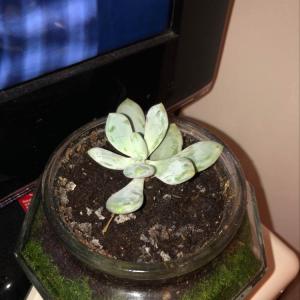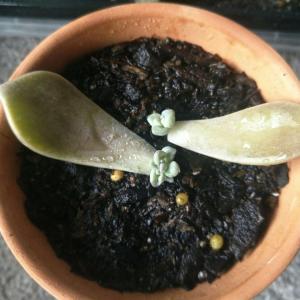求助
Grz1027
2018年01月05日

What kind of succulent do I have? I was thinking that it is an aloe plant, but I'm not sure
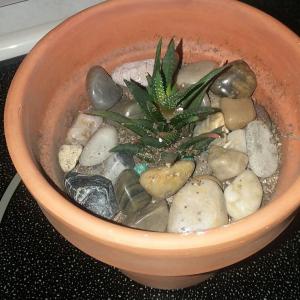

0
0
stunning.succulents:haworthia fasciata?
成长记
mamaberryjournal
2017年12月30日

I now added "grape succulent" in my "garden"
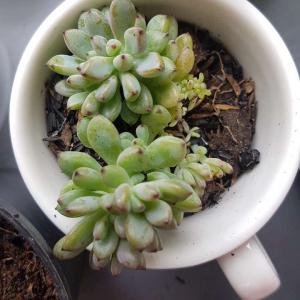

0
0
muhammed micheal:Looks great
求助
chingleng/otter
2017年12月24日

anyone can identify these succulents?
#succulent #identification


#succulent #identification


0
1
Sookie:The one on the right in the picture with 4 succulents looks like Tigers Jaw.
文章
Miss Chen
2017年12月20日

Description: This perennial wildflower is ½–2' tall and either unbranched or sparingly branched. The central stem is green, glabrous to pubescent (usually the latter), terete, erect, and rather succulent. A few alternate leaves occur along the length of the central stem (and any lateral stems); they are widely spreading and slightly recurved. The leaf blades are 2-6" long and ¼–1" across; they are medium green, glabrous (or nearly so), slightly fleshy, linear to lanceolate in shape, parallel-veined, and smooth along their margins. The base of each leaf blade is sessile, or it has short petiole. Each leaf has a closed sheath about ½" long. The upper margin of each sheath is rolled outward, above which there is a tuft of long hairs. There are both axillary and terminal flowers. The flowers usually occur individually, less often in cymes of 2-3.

Each flower spans ¾–1¼" across, consisting of 2 large blue petals (above), 1 small white petal (below), 3 light green sepals, a pistil with a single slender style, and 6 stamens. The petals are well-rounded, but become very narrow at the base. There are 3 kinds of stamens: 3 sterile stamens with cross-shaped pseudo-anthers that are bright yellow, 1 central food stamen with a bright yellow butterfly-shaped anther, and 2 lateral stamens with gray or purple anthers. The sterile stamens (staminodia) are located a little above and behind the food stamen. The pollen of both the food stamen and lateral stamens are yellow. Below each flower, there is a keeled green spathe that resembles the hull of a boat. The upper edges of the spathe are rounded, while the folded edge below is flat and ciliate. The upper edges of the spathe are joined together at the base (behind the flower) for about one-third the length of the spathe, otherwise they are open. Each folded spathe is ½–1½" long and about one-half as much tall. The blooming period occurs from mid-summer to early fall and lasts about 2 months. Each flower remains open for a few hours during the morning, after which it closes. There is no noticeable floral scent. The flowers are capable of self-pollination. Each flower is replaced by a 3-celled seed capsule; each cell of the capsule contains a single seed. Individual seeds are about 1/8" long, brown, and smooth. The root system consists of fleshy fibrous roots. This wildflower reproduces by reseeding itself.
Cultivation: The preference is partial to full sun, mesic to dry conditions, and sandy or rocky soil.
Range & Habitat: The native Slender Dayflower is occasional in the western half of Illinois, NE Illinois, and southern Illinois, otherwise it is absent (see Distribution Map). Habitats include dry sand prairies, sand dunes, upland sandy woodlands, upland rocky woodlands, sandy savannas, thinly wooded bluffs and cliffs, rocky glades, sandy areas along railroads, and areas along sandy paths. Slender Dayflower benefits from occasional wildfires as this reduces the encroachment of woody vegetation. Generally, plants with more slender leaves (var. angustifolia and var. deamii) are more common in prairies than the typical variety.
Faunal Associations: The flowers are pollinated by various long-tongued bees, which collect pollen from the food stamen. No nectar is provided as a floral reward. A group of several leaf beetles (Chrysomelidae) are known to feed on Slender Dayflower; the larvae typically bore through the stems, while the adults occasionally feed on the leaves. These leaf beetle species include: Neolema jacobina, Neolema quadriguttata, Oulema cornuta, Oulema elongata, and Oulema simulans. The seeds of Commelina spp. (Dayflowers) are eaten by the Bobwhite and Mourning Dove, while the foliage is occasionally browsed by White-Tailed Deer, domestic cattle, and similar hoofed mammalian herbivores.
Photographic Location: A sandy path at Hooper Branch Savanna Nature Preserve in Iroquois County, Illinois. The photographed plant is probably Commelina erecta var. deamii.
Comments: Both the flowers and foliage are ornamental. The "true blue" color of the upper petals is very rare among wildflowers. The flowers of Slender Dayflower are very similar to those of the introduced Commelina communis (Asiatic Dayflower). It differs from the latter species by its more erect stems, more slender leaves, and the joined upper margins at the base of its spathes. The Asiatic Dayflower can form rootlets at its nodes, thereby establishing vegetative colonies, and its seeds are irregular and wrinkled. Slender Dayflower, in contrast, does not form rootlets at its nodes and its seeds are smooth. Slender Dayflower is a highly variable species, and three different varieties have been described for Illinois: 1) var. erecta has wide leaves (¾" or more) and large spathes (¾–1½" long), 2) var. angustifolia has narrow leaves (less than ¾" across) and small spathes (less than ¾" long), and 3) var. deamii has narrow leaves (less than ¾" across) and large spathes (¾–1½" long). Because these three varieties can intergrade, some field specimens may be difficult to classify.

Each flower spans ¾–1¼" across, consisting of 2 large blue petals (above), 1 small white petal (below), 3 light green sepals, a pistil with a single slender style, and 6 stamens. The petals are well-rounded, but become very narrow at the base. There are 3 kinds of stamens: 3 sterile stamens with cross-shaped pseudo-anthers that are bright yellow, 1 central food stamen with a bright yellow butterfly-shaped anther, and 2 lateral stamens with gray or purple anthers. The sterile stamens (staminodia) are located a little above and behind the food stamen. The pollen of both the food stamen and lateral stamens are yellow. Below each flower, there is a keeled green spathe that resembles the hull of a boat. The upper edges of the spathe are rounded, while the folded edge below is flat and ciliate. The upper edges of the spathe are joined together at the base (behind the flower) for about one-third the length of the spathe, otherwise they are open. Each folded spathe is ½–1½" long and about one-half as much tall. The blooming period occurs from mid-summer to early fall and lasts about 2 months. Each flower remains open for a few hours during the morning, after which it closes. There is no noticeable floral scent. The flowers are capable of self-pollination. Each flower is replaced by a 3-celled seed capsule; each cell of the capsule contains a single seed. Individual seeds are about 1/8" long, brown, and smooth. The root system consists of fleshy fibrous roots. This wildflower reproduces by reseeding itself.
Cultivation: The preference is partial to full sun, mesic to dry conditions, and sandy or rocky soil.
Range & Habitat: The native Slender Dayflower is occasional in the western half of Illinois, NE Illinois, and southern Illinois, otherwise it is absent (see Distribution Map). Habitats include dry sand prairies, sand dunes, upland sandy woodlands, upland rocky woodlands, sandy savannas, thinly wooded bluffs and cliffs, rocky glades, sandy areas along railroads, and areas along sandy paths. Slender Dayflower benefits from occasional wildfires as this reduces the encroachment of woody vegetation. Generally, plants with more slender leaves (var. angustifolia and var. deamii) are more common in prairies than the typical variety.
Faunal Associations: The flowers are pollinated by various long-tongued bees, which collect pollen from the food stamen. No nectar is provided as a floral reward. A group of several leaf beetles (Chrysomelidae) are known to feed on Slender Dayflower; the larvae typically bore through the stems, while the adults occasionally feed on the leaves. These leaf beetle species include: Neolema jacobina, Neolema quadriguttata, Oulema cornuta, Oulema elongata, and Oulema simulans. The seeds of Commelina spp. (Dayflowers) are eaten by the Bobwhite and Mourning Dove, while the foliage is occasionally browsed by White-Tailed Deer, domestic cattle, and similar hoofed mammalian herbivores.
Photographic Location: A sandy path at Hooper Branch Savanna Nature Preserve in Iroquois County, Illinois. The photographed plant is probably Commelina erecta var. deamii.
Comments: Both the flowers and foliage are ornamental. The "true blue" color of the upper petals is very rare among wildflowers. The flowers of Slender Dayflower are very similar to those of the introduced Commelina communis (Asiatic Dayflower). It differs from the latter species by its more erect stems, more slender leaves, and the joined upper margins at the base of its spathes. The Asiatic Dayflower can form rootlets at its nodes, thereby establishing vegetative colonies, and its seeds are irregular and wrinkled. Slender Dayflower, in contrast, does not form rootlets at its nodes and its seeds are smooth. Slender Dayflower is a highly variable species, and three different varieties have been described for Illinois: 1) var. erecta has wide leaves (¾" or more) and large spathes (¾–1½" long), 2) var. angustifolia has narrow leaves (less than ¾" across) and small spathes (less than ¾" long), and 3) var. deamii has narrow leaves (less than ¾" across) and large spathes (¾–1½" long). Because these three varieties can intergrade, some field specimens may be difficult to classify.
0
0
求助
elvenking42
2017年12月03日

strange succulent texture? My lithops, and two other succulents are less firm than they should be.. there's no discoloration but they act like they're overwater. should I water them more? or I'd there something else wrong with them?
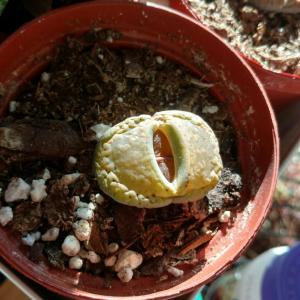

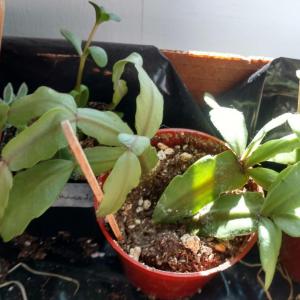



1
0
meriunkat:is the temperature really hot over there? it might be that the sunlight is being a little too harsh on them😯
文章
Miss Chen
2017年11月22日

Biting into a sweet, succulent cherry tomato is one of the joys of summer, and somehow it tastes even better when you grew it yourself. Cherry tomatoes are not difficult to grow in a home garden, but just because cherry tomatoes are petite doesn't mean the plants are; like many tomato cultivars, some cherry tomato plants have a tendency to sprawl, and there are many good reasons to tidy them up. With some basic pruning techniques, you can trim back your cherry tomato plants fairly quickly, and get back to enjoying your summer salad.

Types to Prune
Tomato plants fall into one of two types: determinate and indeterminate. They are determinate if they form a terminal, or top, flower cluster, which is what causes them to stop growing in height. Because they grow to a fixed size and produce a fixed number of cherry tomatoes, determinates should not be pruned, although you should remove the shoots below the first flower cluster. Plants with lateral flower clusters, and no terminal, are indeterminates; their fruit ripens more slowly, and they will keep growing until killed by frost. These are the type of cherry tomato plants which should be pruned. Indeterminate cherry tomato cultivars include Super Sweets, Sweet Million, Large Red Cherry and Yellow Pear; determinate varieties include Tiny Tim and Mountain Belle.
Benefits of Pruning
Prune your indeterminates to maximize the efficiency of photosynthesis and minimize disease. In the process of vigorous growing, they send out "suckers", or shoots, that come from the main stem and can turn into main stems themselves, which send out more shoots. Although this makes the plant produce more fruit, the benefit is outweighed when the main stem can no longer bear the weight and the plant sprawls on the ground. This is not only unsightly but destructive; as fruit falls in the dirt, it is exposed to damage from insects and viruses. On the other hand, a pruned and supported single-stem tomato plant has all its fruit in the air, its leaves exposed to the sun, and flavor-enhancing sugar going to the developing fruit, since the plant is only growing at the tip. The cherry tomatoes will be larger and tastier, and will form more quickly. In addition, the leaves dry off faster when it the plant is pruned and supported, reducing the risk of bacterial and fungal infections.

Pruning Techniques
Prune the cherry tomato plant to one or—at most—two main stems, and remove lower branches to deter splashback reinfection of pathogens left in the dirt from previous years. Pinch the new suckers soon after they appear. The best way to do this is with your fingers, twisting the sucker until it snaps off; this results in a more desirable break from the stem than would occur with the use of scissors. If you've let suckers grow too long and they are hard to snap off manually, use a retractable knife. Avoid sun scald by leaving enough leaves to cover and protect the tomatoes, and prevent fungal infection by never pruning a wet tomato plant. Keep cherry tomatoes free of side stems below the first fruit cluster.

Types to Prune
Tomato plants fall into one of two types: determinate and indeterminate. They are determinate if they form a terminal, or top, flower cluster, which is what causes them to stop growing in height. Because they grow to a fixed size and produce a fixed number of cherry tomatoes, determinates should not be pruned, although you should remove the shoots below the first flower cluster. Plants with lateral flower clusters, and no terminal, are indeterminates; their fruit ripens more slowly, and they will keep growing until killed by frost. These are the type of cherry tomato plants which should be pruned. Indeterminate cherry tomato cultivars include Super Sweets, Sweet Million, Large Red Cherry and Yellow Pear; determinate varieties include Tiny Tim and Mountain Belle.
Benefits of Pruning
Prune your indeterminates to maximize the efficiency of photosynthesis and minimize disease. In the process of vigorous growing, they send out "suckers", or shoots, that come from the main stem and can turn into main stems themselves, which send out more shoots. Although this makes the plant produce more fruit, the benefit is outweighed when the main stem can no longer bear the weight and the plant sprawls on the ground. This is not only unsightly but destructive; as fruit falls in the dirt, it is exposed to damage from insects and viruses. On the other hand, a pruned and supported single-stem tomato plant has all its fruit in the air, its leaves exposed to the sun, and flavor-enhancing sugar going to the developing fruit, since the plant is only growing at the tip. The cherry tomatoes will be larger and tastier, and will form more quickly. In addition, the leaves dry off faster when it the plant is pruned and supported, reducing the risk of bacterial and fungal infections.

Pruning Techniques
Prune the cherry tomato plant to one or—at most—two main stems, and remove lower branches to deter splashback reinfection of pathogens left in the dirt from previous years. Pinch the new suckers soon after they appear. The best way to do this is with your fingers, twisting the sucker until it snaps off; this results in a more desirable break from the stem than would occur with the use of scissors. If you've let suckers grow too long and they are hard to snap off manually, use a retractable knife. Avoid sun scald by leaving enough leaves to cover and protect the tomatoes, and prevent fungal infection by never pruning a wet tomato plant. Keep cherry tomatoes free of side stems below the first fruit cluster.
0
0



